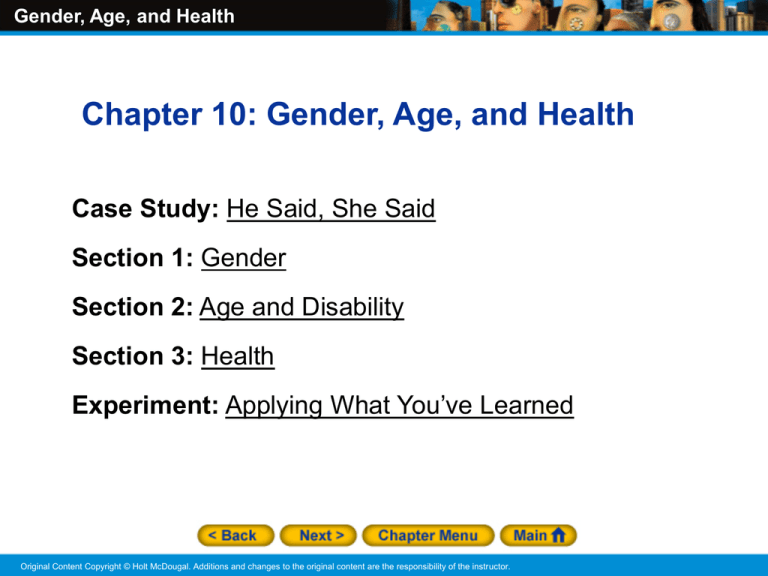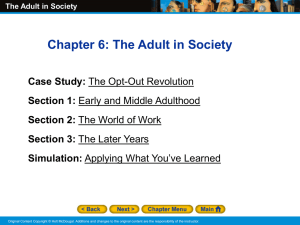
Gender, Age, and Health
Chapter 10: Gender, Age, and Health
Case Study: He Said, She Said
Section 1: Gender
Section 2: Age and Disability
Section 3: Health
Experiment: Applying What You’ve Learned
Original Content Copyright © Holt McDougal. Additions and changes to the original content are the responsibility of the instructor.
Gender, Age, and Health
Case Study: He Said, She Said
Although generalizations can lead to problems,
understanding the differences between gender-based
communication styles can lead to healthier relationships.
Sociolinguist Deborah Tannen likens the difference to
communication across cultures. The differences are
instilled in children as they play. The focus on different
goals for the same conversation can lead to stress.
Original Content Copyright © Holt McDougal. Additions and changes to the original content are the responsibility of the instructor.
Gender, Age, and Health
Original Content Copyright © Holt McDougal. Additions and changes to the original content are the responsibility of the instructor.
Gender, Age, and Health
Section 1 at a Glance
Gender
• The specific behaviors and attitudes that a society
establishes for men and women are called gender roles.
• Individuals learn appropriate gender-role behavior
through socialization.
• Gender roles are both different and unequal. In general,
to be female is to be in a position of lesser power in
society.
• Women have worked hard to overcome inequality in
education, work, and politics.
Original Content Copyright © Holt McDougal. Additions and changes to the original content are the responsibility of the instructor.
Gender, Age, and Health
Gender
Main Idea
• Individuals learn appropriate gender behavior through socialization.
In many societies, gender roles lead to social inequality.
Reading Focus
• How are gender roles and identity formed?
• How does gender play into social inequality in the United States?
Original Content Copyright © Holt McDougal. Additions and changes to the original content are the responsibility of the instructor.
Gender, Age, and Health
How did expectations
about women in the
workplace change
over time?
Original Content Copyright © Holt McDougal. Additions and changes to the original content are the responsibility of the instructor.
Gender, Age, and Health
Gender Roles and Identity
Gender is the behavior and psychological traits considered
appropriate for men and women. Gender roles are the specific
behaviors established by society for men and women. Gender
identity is the awareness of being masculine or feminine as
defined by society.
Between Cultures
• Margaret Mead studied
expectations across three
cultures and found differences.
• Differences are seen as proof
that gender is social, not
biological.
Gender Identity &
Socialization
• Babies are given different toys.
• Expected behavior, interests,
and strengths are different for
young boys and girls.
• Expectations are learned early.
Original Content Copyright © Holt McDougal. Additions and changes to the original content are the responsibility of the instructor.
Gender, Age, and Health
Gender Roles and
Social Inequality
• In most societies, gender is the
primary factor used to
determine a person’s social
standing.
• Sociologists ask why this is.
• One widely held view is that
gender inequality is related to
human reproduction.
• Over time patriarchy, a system
in which men are dominant over
women, arose.
• Conflict perspective suggests
that male control of economic
and political spheres have
reinforced their dominant
position.
• The idea of institutionalized
discrimination is sometimes
given as a reason for
inequality.
• Sexism is the belief that one
sex is by nature superior to the
other.
• Sexism becomes a
self-fulfilling prophecy.
Original Content Copyright © Holt McDougal. Additions and changes to the original content are the responsibility of the instructor.
Gender, Age, and Health
Original Content Copyright © Holt McDougal. Additions and changes to the original content are the responsibility of the instructor.
Gender, Age, and Health
Reading Check
Sequence
How have gender roles changed over time?
Answer: Roles are less restrictive for women, who
are more strongly encouraged now to have
careers and other roles outside the home.
Original Content Copyright © Holt McDougal. Additions and changes to the original content are the responsibility of the instructor.
Gender, Age, and Health
Gender Inequality in the United States
The Women’s Movement
Education
• Officially begun in 1848
• Since 1979, more women
than men in college
• Demanded suffrage, the
right to vote
• Used civil disobedience
• Resurfaced in 1970s
• Women focus on education
and humanities, while men
focus on engineering and the
professions
Original Content Copyright © Holt McDougal. Additions and changes to the original content are the responsibility of the instructor.
Gender, Age, and Health
Gender Inequality in the United States (cont.)
Work
Politics
• Wage gap—The level of
women’s income relative to
that of men
• Women make up 52 percent
of voting-age people, but
only between 16 and 24
percent of elected offices
• Glass ceiling—The invisible
barrier that prevents women
from gaining upper-level
positions
• Some women have been
appointed to high office
• Second shift—The work a
working mother does in the
home
Original Content Copyright © Holt McDougal. Additions and changes to the original content are the responsibility of the instructor.
Gender, Age, and Health
Click on the image to the
left to play the Interactive.
Original Content Copyright © Holt McDougal. Additions and changes to the original content are the responsibility of the instructor.
Gender, Age, and Health
Original Content Copyright © Holt McDougal. Additions and changes to the original content are the responsibility of the instructor.
Gender, Age, and Health
Reading Check
Analyze
How do gender roles affect
the opportunities available to
men and women in American society?
Answer: Often, gender roles influence the types of
careers men and women pursue or dictate which jobs
they will get or how far they will go in their careers.
The glass ceiling still limits women in male-dominated
fields, while similar restrictions do not seem to hinder
men in female-dominated professions.
Original Content Copyright © Holt McDougal. Additions and changes to the original content are the responsibility of the instructor.
Gender, Age, and Health
Section 2 at a Glance
Age and Disability
• While age discrimination still exists, many Americans are
attempting to change the stereotypical image of people
aged 65 and older.
• The populations of the United States and the world are
aging.
• Elderly Americans have become both a political force and
a topic of debate.
• Many people with disabilities, some of whom are also
elderly, face discrimination and prejudice in addition to
dealing with their health problems.
Original Content Copyright © Holt McDougal. Additions and changes to the original content are the responsibility of the instructor.
Gender, Age, and Health
Age and Disability
Main Idea
As society ages, the concerns of the elderly take on increasing
importance. Many elderly people have disabilities, as do many other
Americans.
Reading Focus
• What is ageism?
• What are the population trends of the aging world?
• How do the politics of aging affect elderly Americans?
• What issues do Americans with disabilities face?
Original Content Copyright © Holt McDougal. Additions and changes to the original content are the responsibility of the instructor.
Gender, Age, and Health
Living in the Zone
What's the secret to living
to be 100 years old?
Original Content Copyright © Holt McDougal. Additions and changes to the original content are the responsibility of the instructor.
Gender, Age, and Health
Ageism
• In preindustrial societies, rank rose with age.
• In industrial societies, middle-aged have the greatest social
power.
• Ageism is the belief that one age category is by nature
superior to another age category.
• The stereotype of elderly is unproductive, cranky, and
physically or mentally impaired, but in reality most people over
65 are self-sufficient, active members of society.
• Media uses youth to sell products and focuses on negative
aspects of aging.
Original Content Copyright © Holt McDougal. Additions and changes to the original content are the responsibility of the instructor.
Gender, Age, and Health
Reading Check
Identify Supporting Details
How can ageism be seen
in American society?
Answer: in TV commercials that have older
people selling products such as denture
preparations, burial plans, or medications, or the
news, which focuses on negative aspects of aging
such as poverty and poor health
Original Content Copyright © Holt McDougal. Additions and changes to the original content are the responsibility of the instructor.
Gender, Age, and Health
The Aging World
Today there are about 705 million people aged 60 and
older worldwide. Japan has the oldest population in the
world, while Uganda has the youngest. Median ages are
increasing across the globe.
Aging in the United States
Causes
• The “graying of America” is
the phenomenon of an
increasing percentage of
Americans being 65 or older.
• Advances in health care result
in longer lives.
• The baby-boom generation,
the largest age group in the
United States, is reaching the
age of 65 and older.
Original Content Copyright © Holt McDougal. Additions and changes to the original content are the responsibility of the instructor.
Gender, Age, and Health
Reading Check
Summarize
What are the two primary reasons for the
graying of America?
Answer: People live longer because health care
and living conditions have improved: the huge
baby-boom generation is aging.
Original Content Copyright © Holt McDougal. Additions and changes to the original content are the responsibility of the instructor.
Gender, Age, and Health
Original Content Copyright © Holt McDougal. Additions and changes to the original content are the responsibility of the instructor.
Gender, Age, and Health
The Politics of Aging
• As the number of senior citizens increases, their image has
changed to one of a powerful voting bloc.
• AARP, National Council of Senior Citizens, the National Council
on Aging, and the Gray Panthers are groups that bring attention
to the needs of the aging.
• AARP is the largest special-interest group in the United States.
Original Content Copyright © Holt McDougal. Additions and changes to the original content are the responsibility of the instructor.
Gender, Age, and Health
Challenges to Government
• One major concern is the Social Security system.
• As baby boomers retire, the dependency ratio—the number of
workers for each person receiving Social Security—decreases.
• The number of people receiving benefits is increasing, and they
are receiving benefits for a longer period of time, due to longer
life expectancies.
• Medicare (health insurance for elderly) and Medicaid (health
insurance for low-income) are the sole source of insurance for about
one-fourth of elderly Americans.
Age Inequality in the United States
• Although the elderly are in general better off than other groups,
certain segments of the elderly, such as African Americans and
women, have a higher rate of poverty than the general population.
Original Content Copyright © Holt McDougal. Additions and changes to the original content are the responsibility of the instructor.
Gender, Age, and Health
Reading Check
Analyze
What are the major political issues of
concern to elderly people?
Answer: possible answers—the Social Security
system; health care, especially Medicare and
Medicaid; issues linked to poverty
Original Content Copyright © Holt McDougal. Additions and changes to the original content are the responsibility of the instructor.
Gender, Age, and Health
Americans with Disabilities
The term disability covers a variety of conditions, including
physical disabilities; chronic health impairments; mental
retardation; mental illness; and visual, hearing, or speech
impairments.
Prejudice and
Discrimination
The ADA
• One stereotype is that people
with disabilities cannot do
productive work.
• The Americans with Disabilities
Act (ADA) of 1990 has perhaps
brought the most sweeping
changes.
• Many cannot find jobs and those
that do earn less.
• Government policies aim to fix
this problem.
• The ADA makes discrimination
against people with disabilities
illegal.
Original Content Copyright © Holt McDougal. Additions and changes to the original content are the responsibility of the instructor.
Gender, Age, and Health
Original Content Copyright © Holt McDougal. Additions and changes to the original content are the responsibility of the instructor.
Gender, Age, and Health
Reading Check
Find the Main Idea
What efforts have been made to guarantee
civil rights for Americans with disabilities?
Answer: Education for All Handicapped Children
Act of 1975; Fair Housing Amendments Act of
1988; Americans with Disabilities Act of 1990
Original Content Copyright © Holt McDougal. Additions and changes to the original content are the responsibility of the instructor.
Gender, Age, and Health
Section 3 at a Glance
Health
• Many Americans are concerned about three aspects of
the nation’s health-care system: cost, quality, and access.
• Health care costs are rising, but many Americans are
concerned that the same health insurance plans that
allow them to pay their medical bills may not provide the
highest quality of care.
Original Content Copyright © Holt McDougal. Additions and changes to the original content are the responsibility of the instructor.
Gender, Age, and Health
Section 3 at a Glance (cont.)
Health
• The distribution of physicians, both geographically and
within the medical profession, affects Americans’ access
to health care.
• The health-care system faces such issues as health
insurance, inequality and health, alternative medicine,
and the global challenge of AIDS.
Original Content Copyright © Holt McDougal. Additions and changes to the original content are the responsibility of the instructor.
Gender, Age, and Health
Health
Main Idea
Americans are concerned about the cost and quality of health care. Not
all Americans have equal access to the health-care system.
Reading Focus
• What are the three main concerns about health care in the United
States?
• What are the major issues facing the American health-care system
today?
Original Content Copyright © Holt McDougal. Additions and changes to the original content are the responsibility of the instructor.
Gender, Age, and Health
Do you have a
health clinic in your
grocery store?
Original Content Copyright © Holt McDougal. Additions and changes to the original content are the responsibility of the instructor.
Gender, Age, and Health
Health Care in the United States
Health care is a priority for Americans, who worry about the
cost of, the quality of, and access to health care.
Cost of Health Care
• The United States spends more on health care than any other
country.
• Cost of health care has risen quickly.
• Advances in medical care and increased cost of drugs account for
most of the increase.
Original Content Copyright © Holt McDougal. Additions and changes to the original content are the responsibility of the instructor.
Gender, Age, and Health
Original Content Copyright © Holt McDougal. Additions and changes to the original content are the responsibility of the instructor.
Gender, Age, and Health
Quality of Health Care
Access to Health Care
• Managed care plans provide
members with health-care services
in exchange for a monthly or
annual charge.
•
Studies show a surplus of doctors.
•
Most doctors are concentrated in
wealthy urban and suburban
areas.
•
In poor inner-city and rural areas,
there are fewer doctors but more
people in need of care.
•
Underserved areas usually have a
greater number of people with
chronic diseases and many elderly
people.
•
There are more specialists than
general practitioners.
• The plan limits costs by requiring
members to use certain doctors
and to have certain treatments.
• Although managed care plans have
reduced the cost of care, many
Americans feel that managed care
has reduced the quality of care.
• A “patients’ bill of rights” has been
introduced in Congress several
times, but has never been passed.
Original Content Copyright © Holt McDougal. Additions and changes to the original content are the responsibility of the instructor.
Gender, Age, and Health
Original Content Copyright © Holt McDougal. Additions and changes to the original content are the responsibility of the instructor.
Gender, Age, and Health
Reading Check
Identify Cause and Effect
What trends cause Americans
to be concerned about the cost and
quality of and access to health care?
Answer: rising costs, inability of many to afford or
get approved for insurance, options limited by
cost-control measures of managed-care plans,
shortage of doctors in some areas
Original Content Copyright © Holt McDougal. Additions and changes to the original content are the responsibility of the instructor.
Gender, Age, and Health
Health-Care Issues Today
Health Insurance
Alternative Medicine
• 84 percent of medical costs are
covered by insurance.
• Alternative medicine uses
unconventional methods such as
acupuncture, acupressure, or
herbal remedies.
• The kinds of procedures and
treatments covered differ among
private and public insurance plans.
• Some argue for a centrally planned
national health system.
• Alternative methods have little
regulation.
Inequality and Health
AIDS
• Poor people are more likely to
receive inadequate care.
• Acquired immune deficiency
syndrome (AIDS) attacks the
immune system.
• People who live in poverty have a
higher rate of health issues.
• No cure has been found, but new
drugs seem to slow the disease.
Original Content Copyright © Holt McDougal. Additions and changes to the original content are the responsibility of the instructor.
Gender, Age, and Health
Original Content Copyright © Holt McDougal. Additions and changes to the original content are the responsibility of the instructor.
Gender, Age, and Health
Original Content Copyright © Holt McDougal. Additions and changes to the original content are the responsibility of the instructor.
Gender, Age, and Health
Reading Check
Infer
How are these four issues affecting the
American health-care system?
Answer: health insurance—access issues because
not all employers cover it, companies can reject
people for pre-existing conditions; inequality—lack of
insurance for some, shortage of doctors in poor and
rural areas; alternative medicine—not scientifically
tested, often not covered by insurance; AIDS—number
of people infected strains the system, no cure, fatal
Original Content Copyright © Holt McDougal. Additions and changes to the original content are the responsibility of the instructor.
Gender, Age, and Health
Experiment: Applying What You’ve Learned
Testing Gender Differences
Are men and women really that different from each other?
1. Introduction
• In this lab, you will explore the
differences between men and
women.
2. Review the Research
Process
• As a group, review the sevenstep process of designing an
experiment. Look back to
• Work in small groups to review
Chapter 1 for a detailed
the process of creating an
explanation.
experiment and brainstorm a list
of differences.
• Form a hypothesis and present
it to the class.
Original Content Copyright © Holt McDougal. Additions and changes to the original content are the responsibility of the instructor.
Gender, Age, and Health
Original Content Copyright © Holt McDougal. Additions and changes to the original content are the responsibility of the instructor.
Gender, Age, and Health
Experiment (cont.)
3. Discuss Gender
Differences
4. Design Your Experiment
• Create a list of differences in
social characteristics of men
and women.
• Determine what data you need.
• What are some stereotypes of
men and women?
• In what ways might men and
women be different?
• How do we measure
differences?
• Form a hypothesis.
• Design an experiment to gather
this data.
• Consider what results you
expect.
• What conclusions can you draw
about human behavior?
Original Content Copyright © Holt McDougal. Additions and changes to the original content are the responsibility of the instructor.
Gender, Age, and Health
Experiment (cont.)
5. Present Your
Experiment
6. Discussion
• Describe your group’s experiment
with the class.
• What did you learn from this lab?
As a group, discuss the
following:
• What concerns do your classmates
have?
• How successful was the class at
designing experiments?
• How would your classmates have
improved the experiment?
• What did the best experiments
have in common?
• Can your classmates replicate your
experiment?
• What were some common
weaknesses in the experiments?
• Use your classmates’ comments
to revise and improve your
experiment, and prepare a written
description for your teacher.
• Why do stereotypes persist?
• Would your data have been
different if your experiment were
performed in a different country?
Original Content Copyright © Holt McDougal. Additions and changes to the original content are the responsibility of the instructor.








